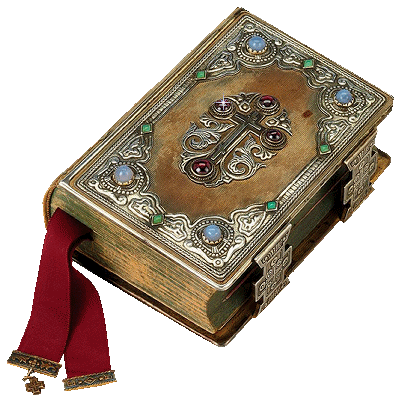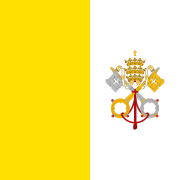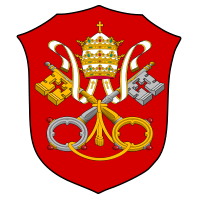 |
Orthodox Outlet for Dogmatic Enquiries | Digital Books |
|---|
UNIA: The Face and the Disguise
11. NO to disorientation!
It is imperative for one to understand that our problem is not Unia per se. Unia is nothing more than a tragic puppet in the hands of a puppet-master, the Vatican. It is the Vatican that is pulling its strings. The problem has to be traced back to the nature of Papism. Is the Papacy a "Church"? This was the question that was so astutely posed to the Professors of Theology (with his familiar, blunt outspokenness) by His Beatitude, our Archbishop Seraphim on the occasion of the feast of Photios the Great ( 6th February 1992 ). What exactly is the Vatican, which constitutes the "other aspect" of the "Roman Catholic Church" that we are conversing with?
The "Vatican" - or "Holy See" - is a State (Stato della Citta del Vaticano). It covers an area of 0,44 square kilometres and its population is 1000 inhabitants, mainly Italians and Swiss. It has a flag of its own, with a special coat-of-arms.

 Flag of the Vatican State Papal Coat of Arms
Flag of the Vatican State Papal Coat of ArmsIt is an entirely independent state. In older times of course, the Pope's dominion covered a far greater expanse. Its current borders were determined on the 11th of February 1929, upon an agreement between Pope Pius XI and Mussolini. Head of the State of Vatican is the head of the "Roman Catholic Church" - in other words, the Pope himself. This same person is also the bearer of both political and religious authority (theocracy). Thus, the Pope continues to this day to be a political leader-head of state, and this is evidenced by his established (ecclesiastic) titles:
· Bishop of Rome
· Vicar of Christ
· Successor to the Prince of the Apostles
· Supreme Pontiff of the Universal Church
· Primate of Italy
· Archbishop and Metropolitan of the Roman Province
· Sovereign of the State of the Vatican City
· Servant of the Servants of God
· Patriarch of the West (dropped 2006)
· Vicar of the Apostolic See
· Vicar of Peter
· Patriarch of the West
· Sovereign Teacher
· Legislator
· Judge
· Commander in charge
These are the (dogmatically) established and currently in use titles of the Pope.
The Pope's State has its own garrison (Swiss guards), a prison, currency (lira), courts of law, ministries, diplomats, audio-visual Media, news agency (Fides), newspapers (the main one is the "Osservatore Romano", since 1861), palaces (Belvedere, Lateran), and above all, Banks.
The Vatican's currency (Lira)
So, is the Papacy really a Church? We are already helped by Athanasius the Great in taking an objective stance on the issue. The Arians had everything that the Orthodox did; however, they regarded both the Son and the Spirit as creations. Athanasius the Great counsels the Orthodox on this matter, to not be fooled by external appearances (vestments, worship, organization) and thus regard them as being Christians, but to consider them as "Ario-maniacs" (i.e., maniacal followers of Arius). The Sacraments are important, not as rituals, but only because they are the conveyers of uncreated Grace. "Where the Church is, there the Holy Spirit (Grace) is", according to Saint Irenaeus (2nd century). The blessed fr. Justin Popovic places Papism in the category of "modern European Arianism". The wise, 18th century Archbishop Eugenios Bulgaris (1806) admits that Papism lost its ecclesiastic prerequisites and has no genuine Saints (Epistle to Claercion). As also admitted by contemporary major theologians, Papism claims that it accepts the (ancient) ecumenical councils, but it has lost the Scriptural and Patristic prerequisites thereof (spirituality, therapeutic character of the dogmas). Furthermore, with the warping of the Sacred Symbol of Faith (with the Filioque), it has adulterated the conciliar tradition of the Church. The Papist dogmas cannot find any ground in the Holy Bible and in its continuance - Patristic theology - because they are the fruits of scholasticism.
More importantly, some people ask: Has Roman Catholicism been condemned by an Ecumenical Council as a heresy? The answer is affirmative. The Council of Constantinople in 879 during Photios' time is, for Orthodoxy, the 8th Ecumenical Council (I.Karmiris, fr. J. Romanides, e.a.), just as the Hesychast Synods of the 14th century (1341, 1347, 1351) are the 9th Ecumenical Council of Orthodoxy. There cannot be a Major Synod of Orthodoxy that will not proclaim them as Ecumenical. The Council of 879 had condemned as a heresy the insertion of the Filioque in the Sacred Symbol of Faith, along with the perpetrators. Thus, there has indeed been an ecumenical condemnation of Franco-Papism in regard to the heresy of the Filioque - which of course was the culmination of its overall estrangement, given that the presuppositions which had led to the heresy of the Filioque were far more significant than the addition itself. That is why the removal of the Filioque from the Symbol is not enough, unless the presuppositions of this fallacy are also rejected (that is, the anti-Scriptural and anti-Patristic theologizing; in other words, the Frankish introduction of Metaphysics in ecclesiastic theologizing).
____________
Article published in English on: 20-2-2009.
Last Update: 4-11-2014.